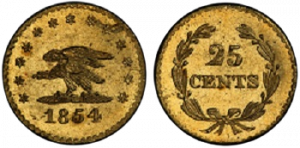How California Fractional Gold Built the West
Posted on — Leave a commentThe California gold rush became an industry of its own soon after the discovery of gold in the American west. Like any industry, the gold rush needed a system of trade. Developing such a system required the creation of California fractional gold. Some believe that before the creation of California fractional gold people would make daily purchases with a pinch of gold dust. It wasn’t long before those traveling west realized that a better system was needed.
Pioneers and others needed coins of small denominations. These smaller value coins were necessary for executing the daily sale and the purchase of everyday items. Between 1849 and 1856, various assayers minted gold coins in values of $0.25, $0.50, $1, $5, $10, $20, $25, and $50. It is likely that the majority of minters were jewelers who had experience working with small pieces of metal.
These pieces were not recognized as government-issued legal tender because they were minted independently. Therefore, while commonly referred to as coins, they are, strictly speaking, more accurately classified as “coin-like ingots.” Those pieces that are non-denominated are referred to as “tokens.”
California gold coins were a solution to the challenge of using silver coins for trade in the west. Many of these silver pieces were foreign which made them impractical. There were many varieties and often the intrinsic value of the coin was worth less than their trading value.
Today, there are 450 known California gold coin varieties. Many of these have no mint marking or are marked only with a set of initials, and are round or octagonal. Despite the anonymity of these coins, many believe that the majority were minted in San Francisco, and Leavenworth, Kansas. The process of making the coins was imprecise because they were minted without the industrial equipment found in the east coast mints of the US at that time. Assayers used the hammer method. This was a crude, but effective approach in which the minter simply used a sledgehammer to strike the die into the blank coin.
Many of these coins are highly sought after among collectors. In 2021, one collector holding 124 different varieties of California fractional gold sold his entire set. Among these varieties was the Defiant Eagle $0.25 coin minted in 1854. The highest recorded auction of this coin is $59,800 earned in 2009.
By 1864 the US government decided to make the practice of producing coins like these illegal with the passage of the Coinage Act.
For many collectors, the allure of the coins is not only their rarity but the industrious spirit they represent. The coins are an example of how the American west was developed by people, as much as it was the government. California fractional gold coins enabled the emerging economy that gave rise to what are some of the biggest economies in the world today. Moreover, these pieces were the currency of the “everyman” rather than the wealthy elite. They were used for basic purchases that were part of everyday life.
Want to read more? Subscribe to the Blanchard Newsletter and get our tales from the vault, our favorite stories from around the world and the latest tangible assets news delivered to your inbox weekly.








